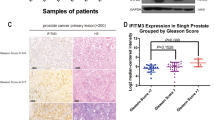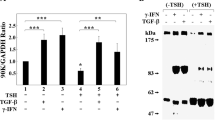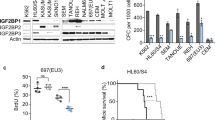Abstract
Osteopontin is a secreted, integrin-binding and phosphorylated acidic glycoprotein, which has an important role in tumour progression. We have shown that Wnt, Ets, AP-1, c-jun and β-catenin/Lef-1/Tcf-1 stimulates OPN transcription in rat mammary carcinoma cells by binding to a specific promoter sequence. However, co-repressors of OPN have not been identified. In this study, we have used the bacterial two-hybrid system to isolate cDNA-encoding proteins that bind to OPN and modulate its role in malignant transformation. Using this approach we isolated interferon-induced transmembrane protein 3 gene (IFITM3) as a potential protein partner. We show that IFITM3 and OPN interact in vitro and in vivo and that IFITM3 reduces osteopontin (OPN) mRNA expression, possibly by affecting OPN mRNA stability. Stable transfection of IFITM3 inhibits OPN, which mediates anchorage-independent growth, cell adhesion and cell invasion. Northern blot analysis revealed an inverse mRNA expression pattern of IFITM3 and OPN in human mammary cell lines. Inhibition of IFITM3 by antisense RNA promoted OPN protein expression, enhanced cell invasion by parental benign non-invasive Rama 37 cells, indicating that the two proteins interact functionally as well. We also identified an IFITM3 DNA-binding domain, which interacts with OPN, deletion of which abolished its inhibitive effect on OPN. This work has shown for the first time that IFITM3 physically interacts with OPN and reduces OPN mRNA expression, which mediates cell adhesion, cell invasion, colony formation in soft agar and metastasis in a rat model system.
This is a preview of subscription content, access via your institution
Access options
Subscribe to this journal
Receive 50 print issues and online access
$259.00 per year
only $5.18 per issue
Buy this article
- Purchase on Springer Link
- Instant access to full article PDF
Prices may be subject to local taxes which are calculated during checkout





Similar content being viewed by others
Abbreviations
- OPN:
-
osteopontin
- MAb:
-
monoclonal antibody
- Rama:
-
rat mammary
- SDS:
-
sodium dodecyl sulphate
References
Andreu P, Colnot S, Godard C, Laurent-Puig P, Lamarque D, Kahn A et al. (2006). Identification of the IFITM family as a new molecular marker in human colorectal tumors. Cancer Res 66: 1949–1955.
Behrend EI, Craig AM, Wilson SM, Denhardt DT, Chambers AF . (1994). Reduced malignancy of ras-transformed NIH 3T3 cells expressing antisense osteopontin RNA. Cancer Res 54: 832–837.
Brady ME, Ozanne DM, Gaughan L, Waite I, Cook S, Neal DE et al. (1999). Tip60 is a nuclear hormone receptor coactivator. J Biol Chem 274: 17599–17604.
Brem R, Oroszlan-Szovik K, Foser S, Bohrmann B, Certa U . (2003). Inhibition of proliferation by 1-8U in interferon-alpha-responsive and non-responsive cell lines. Cell Mol Life Sci 60: 1235–1248.
Chen H, Ke Y, Oates AJ, Barraclough R, Rudland PS . (1997). Isolation of and effector for metastasis-inducing DNAs from a human metastatic carcinoma cell line. Oncogene 14: 1581–1588.
Denhardt DT, Guo X . (1993). Osteopontin: a protein with diverse functions. FASEB J 7: 1475–1482.
Dunnington DJ, Hughes CM, Monaghan P, Rudland PS . (1983). Phenotypic instability of rat mammary tumor epithelial cells. J Natl Cancer Inst 71: 1227–1240.
El-Tanani M, Barraclough R, Wilkinson MC, Rudland PS . (2001). Metastasis-inducing DNA regulates the expression of the osteopontin gene by binding the transcription factor Tcf-4. Cancer Res 61: 5619–5629.
El-Tanani M, Platt-Higgins A, Rudland PS, Campbell FC . (2004). Ets gene PEA3 cooperates with beta-catenin-Lef-1 and c-Jun in regulation of osteopontin transcription. J Biol Chem 279: 20794–20806.
El-Tanani MK, Campbell FC, Crowe P, Erwin P, Harkin DP, Pharoah P et al. (2006). BRCA1 suppresses osteopontin-mediated breast cancer. J Biol Chem 281: 26587–26601.
Euer N, Schwirzke M, Evtimova V, Burtscher H, Jarsch M, Tarin D et al. (2002). Identification of genes associated with metastasis of mammary carcinoma in metastatic versus non-metastatic cell lines. Anticancer Res 22: 733–740.
Evans SS, Collea RP, Leasure JA, Lee DB . (1993). IFN-alpha induces homotypic adhesion and Leu-13 expression in human B lymphoid cells. J Immunol 150: 736–747.
Geissinger E, Weisser C, Fischer P, Schartl M, Wellbrock C . (2002). Autocrine stimulation by osteopontin contributes to antiapoptotic signalling of melanocytes in dermal collagen. Cancer Res 62: 4820–4828.
Green CD, Thompson PD, Johnston PG, El-Tanani MK . (2007). Interaction between transcription factor, basal transcription factor 3, and the NH2-terminal domain of human estrogen receptor alpha. Mol Cancer Res 5: 1191–1200.
Hsieh YH, Juliana MM, Hicks PH, Feng G, Elmets C, Liaw L et al. (2006). Papilloma development is delayed in osteopontin-null mice: implicating an antiapoptosis role for osteopontin. Cancer Res 66: 7119–7127.
Jin D, El-Tanani M, Campbell FC . (2006). Identification of apolipoprotein D as a novel inhibitor of osteopontin-induced neoplastic transformation. Int J Oncol 29: 1591–1599.
Khan SA, Lopez-Chua CA, Zhang J, Fisher LW, Sorensen ES, Denhardt DT . (2002). Soluble osteopontin inhibits apoptosis of adherent endothelial cells deprived of growth factors. J Cell Biochem 85: 728–736.
Lange UC, Saitou M, Western PS, Barton SC, Surani MA . (2003). The fragilis interferon-inducible gene family of transmembrane proteins is associated with germ cell specification in mice. BMC Dev Biol 3: 1–11.
Lewin AR, Reid LE, McMahon M, Stark GR, Kerr IM . (1991). Molecular analysis of a human interferon-inducible gene family. Eur J Biochem 199: 417–423.
Liu D, Rudland PS, Sibson DR, Barraclough R . (2002). Identification of mRNAs differentially-expressed between benign and malignant breast tumour cells. Br J Cancer 87: 423–431.
Meller R, Stevens SL, Minami M, Cameron JA, King S, Rosenzweig H et al. (2005). Neuroprotection by osteopontin in stroke. J Cereb Blood Flow Metab 25: 217–225.
Nicolini A, Carpi A, Rossi G . (2006). Cytokines in breast cancer. Cytokine Growth Factor Rev 17: 325–337.
Oates AJ, Barraclough R, Rudland PS . (1996). The identification of osteopontin as a metastasis-related gene product in a rodent mammary tumour model. Oncogene 13: 97–104.
Olesen JT, Fikes JD, Guarente L . (1991). The Schizosaccharomyces pombe homolog of Saccharomyces cerevisiae HAP2 reveals selective and stringent conservation of the small essential core protein domain. Mol Cell Biol 11: 611–619.
Rassart E, Bedirian A, Carmo SD, Guinard O, Sirois J, Terrisse L et al. (2000). Apolipoprotein D. Biochimica et Biophysica Acta 1482: 185–198.
Real SM, Marzese DM, Gomez LC, Mayorga LS, Roque M . (2006). Development of a Premature Stop Codon-detection method based on a bacterial two hybrid system. BMC Biotechnol 6: 1–12.
Rittling SR, Chen Y, Feng F, Wu Y . (2002). Tumor-derived osteopontin is soluble, not matrix associated. J Biol Chem 277: 9175–9182.
Rudland PS, Platt-Higgins A, El-Tanani M, De Silva Rudland S, Barraclough R, Winstanley JH et al. (2002). Prognostic significance of the metastasis-associated protein osteopontin in human breast cancer. Cancer Res 62: 3417–3427.
Rudland PS, Platt-Higgins A, Renshaw C, West CR, Winstanley JH, Robertson L et al. (2000). Prognostic significance of the metastasis-inducing protein S100A4 (p9Ka) in human breast cancer. Cancer Res 60: 1595–1603.
Singhal H, Bautista DS, Tonkin KS, O’Malley FP, Tuck AB, Chambers AF et al. (1997). Elevated plasma osteopontin in metastatic breast cancer associated with increased tumor burden and decreased survival. Clin Cancer Res 3: 605–611.
Tanaka SS, Nagamatsu G, Tokitake Y, Kasa M, Tam PPL, Matsui Y . (2004). Regulation of expression of mouse interferon-induced transmembrane protein like gene-3 ifitm3(mil-1, fragilis), in germ cells. Dev Dyn 230: 651–659.
Tanaka SS, Yamaguchi YL, Tsoi B, Lickert H, Tam PP . (2005). IFITM/Mil/fragilis family proteins IFITM1 and IFITM3 play distinct roles in mouse primordial germ cell homing and repulsion. Dev Cell 9: 745–756.
Tuck AB, O’Malley FP, Singhal H, Harris JF, Tonkin KS, Kerkvliet N et al. (1998). Osteopontin expression in a group of lymph node negative breast cancer patients. Int J Cancer 79: 502–508.
Ue T, Yokozaki H, Kitadai Y, Yamamoto S, Yasui W, Ishikawa T et al. (1998). Co-expression of osteopontin and CD44v9 in gastric cancer. Int J Cancer 79: 127–132.
Yang HL, Jiang HJ, Fang WY, Xu YY, Liao DF, He FC . (2005a). High fidelity PCR with an off/on switch mediated by proofreading polymerases combining with phosphorothioate-modified primer. Biochem Biophys Res Commun 38: 265–272.
Yang Y, Lee JH, Kim KY, Song HK, Kim JK, Yoon SR et al. (2005b). The interferon-inducible 9–27 gene modulates the susceptibility to natural killer cells and the invasiveness of gastric cancer cells. Cancer Lett 221: 191–200.
Zhang J, Guo H, Mi Z, Gao C, Bhattacharya S, Li J et al. (2009). EF1A1-actin interactions alter mRNA stability to determine differential osteopontin expression in HepG2 and Hep3B cells. Exp Cell Res 315: 304–312.
Acknowledgements
We acknowledge support from Research and Development Office (R&D), Queen's University Belfast, Northern Ireland, United Kingdom.
Author information
Authors and Affiliations
Corresponding author
Rights and permissions
About this article
Cite this article
El-Tanani, M., Jin, D., Campbell, F. et al. Interferon-induced transmembrane 3 binds osteopontin in vitro: expressed in vivo IFITM3 reduced OPN expression. Oncogene 29, 752–762 (2010). https://doi.org/10.1038/onc.2009.379
Received:
Revised:
Accepted:
Published:
Issue Date:
DOI: https://doi.org/10.1038/onc.2009.379
Keywords
This article is cited by
-
More than meets the I: the diverse antiviral and cellular functions of interferon-induced transmembrane proteins
Retrovirology (2017)
-
The role of IFITM3 in the growth and migration of human glioma cells
BMC Neurology (2013)
-
Expression of osteopontin coregulators in primary colorectal cancer and associated liver metastases
British Journal of Cancer (2011)
-
Important role of integrins in the cancer biology
Cancer and Metastasis Reviews (2010)



